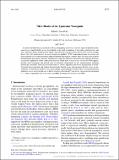| dc.contributor.author | Emanuel, Kerry Andrew | |
| dc.date.accessioned | 2021-11-16T16:03:35Z | |
| dc.date.available | 2021-10-27T19:56:40Z | |
| dc.date.available | 2021-11-16T16:03:35Z | |
| dc.date.issued | 2020 | |
| dc.identifier.uri | https://hdl.handle.net/1721.1/133787.2 | |
| dc.description.abstract | Ó 2020 American Meteorological Society. A recently developed linear model of eastward-propagating disturbances has two separate unstable modes: convectively coupled Kelvin waves destabilized by the wind dependence of the surface enthalpy flux, and slow, MJO-like modes destabilized by cloud–radiation interaction and driven eastward by surface enthalpy fluxes. This latter mode survives the weak temperature gradient (WTG) approximation and has a time scale dictated by the time it takes for surface fluxes to moisten tropospheric columns. Here we extend that model to include higher-order modes and show that planetary-scale low-frequency waves with more complex structures can also be amplified by cloud–radiation interactions. While most of these waves survive the WTG approximation, their frequencies and growth rates are seriously compromised by that approximation. Applying instead the assumption of zonal geostrophy results in a better approximation to the full spectrum of modes. For small cloud–radiation and surface flux feedbacks, Kelvin waves and equatorial Rossby waves are destabilized, but when these feedbacks are strong enough, the frequencies do not lie close to classical equatorial dispersion curves except in the case of higher-frequency Kelvin and Yanai waves. An eastward-propagating n 5 1 mode, in particular, has a structure resembling the observed structure of the MJO. | en_US |
| dc.language.iso | en | |
| dc.publisher | American Meteorological Society | en_US |
| dc.relation.isversionof | 10.1175/JAS-D-19-0281.1 | en_US |
| dc.rights | Article is made available in accordance with the publisher's policy and may be subject to US copyright law. Please refer to the publisher's site for terms of use. | en_US |
| dc.source | American Meteorological Society (AMS) | en_US |
| dc.title | Slow Modes of the Equatorial Waveguide | en_US |
| dc.type | Article | en_US |
| dc.contributor.department | Massachusetts Institute of Technology. Department of Earth, Atmospheric, and Planetary Sciences | en_US |
| dc.contributor.department | Lorenz Center (Massachusetts Institute of Technology) | en_US |
| dc.relation.journal | Journal of the Atmospheric Sciences | en_US |
| dc.eprint.version | Final published version | en_US |
| dc.type.uri | http://purl.org/eprint/type/JournalArticle | en_US |
| eprint.status | http://purl.org/eprint/status/PeerReviewed | en_US |
| dc.date.updated | 2021-09-16T12:17:27Z | |
| dspace.orderedauthors | Emanuel, K | en_US |
| dspace.date.submission | 2021-09-16T12:17:29Z | |
| mit.journal.volume | 77 | en_US |
| mit.journal.issue | 5 | en_US |
| mit.license | PUBLISHER_POLICY | |
| mit.metadata.status | Publication Information Needed | en_US |
